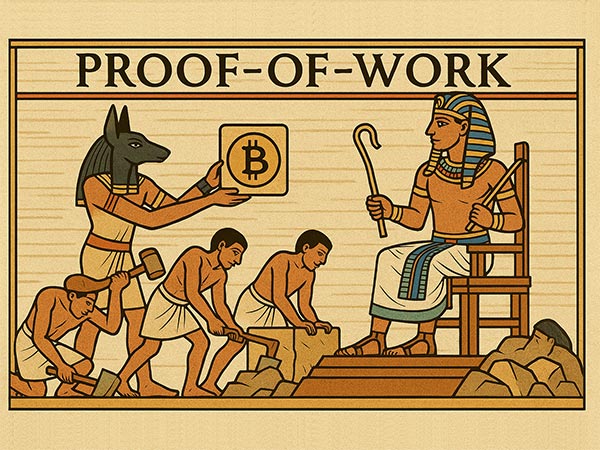The Proof-of-Work (PoW) Revolution in 2025: Energy Mining and the Bitcoin Halving

Deep in the deserts of Texas, rows of container-converted data centers are consuming electricity equivalent to that of a small country. But instead of running AI models, these facilities power tens of thousands of mining machines securing the Bitcoin network. In 2024, with the arrival of the fourth halving event, the Proof-of-Work (PoW) mechanism is undergoing the most profound transformation since its inception. Once criticized as “wasteful energy,” PoW is now evolving into an alternative testing ground for global energy transformation.
Electricity is Power: Restructuring the Logic of PoW
In 2025, Bitcoin’s total network hashrate surpassed 700 EH/s (equivalent to 70 quintillion hash calculations per second), driven by a fierce competition in the physical energy world. The core principle remains unchanged: miners consume electricity to solve cryptographic puzzles in exchange for block rewards and transaction validation rights. But the operational logic has fundamentally shifted:
-
Energy conversion efficiency as a competitive edge:
Leading mining firms like Riot Platforms deploy mining machines in fragile power grid zones, acting as “flexible loads.” During the 2024 California heatwave, these mining farms were able to shut down within 90 seconds, returning power to residential systems and earning $285 per megawatt-hour in compensation—far more than mining revenue. -
Carbon neutrality driving technological innovation:
With the EU Carbon Border Adjustment Mechanism (CBAM) extending to data centers in 2025, Iceland-based mining farms are forced to monetize geothermal carbon credits. Marathon Digital uses carbon credit trading to reduce its Bitcoin production cost to $18,000 per coin (vs. market price of $63,000). -
Financialization of hashrate accelerating:
Publicly traded miners like Bitfarms include hashrate futures in their balance sheets. In their Q1 2025 earnings, 27% of revenue came from hashrate derivatives, forming a dual-engine model of “mining + finance.”
Energy Alchemy: Transforming Waste into Digital Value
PoW’s most disruptive value lies in converting near-zero marginal cost energy into digital gold. Innovative practices in 2024 are rewriting energy economics:
-
Monetizing flared natural gas:
In North Dakota’s Bakken oil fields, previously flared associated gas is now used to power mobile mining rigs. Crusoe Energy’s system turns each thousand cubic feet of gas into $8 worth of BTC, while reducing CO₂-equivalent emissions by 63%. By 2025, the project processes 12% of the U.S.’s associated gas. -
Nuclear load balancing:
NuScale’s modular small reactors, deployed in 2024, achieved commercial “nuclear-powered mining.” During off-peak grid hours, Ohio’s nuclear plants redirect excess power to mining farms, maintaining a 98% utilization rate (vs. 60% industry average). This base-load regulation reduces electricity costs to $0.021 per kWh. -
Data center heat recovery:
Sweden’s Stockholm Data Parks connects mining machine exhaust heat to district heating systems. Every 1 MWh of electricity consumed generates 0.97 MWh of usable heat, enough to warm 2,000 homes in winter. This cogeneration model transforms mining from energy consumer into urban infrastructure.
The Halving Era: Miners Evolve Under New Survival Rules
The fourth Bitcoin halving in April 2024 reduced block rewards from 6.25 BTC to 3.125 BTC. This existential challenge has driven a deep restructuring of the industry:
-
Efficiency arms race intensifies:
Bitmain’s mass-produced S21 Hydra mining rig in 2025 achieves 15 J/TH efficiency—an 83% improvement over four years. But the true revolution lies in modular design: upgradeable hashboards extend lifespan to over five years, ending the 18-month full replacement cycle. -
Rise of decentralized hashrate markets:
Through GPU networks like Nosana, ordinary users can mine PoW tokens with gaming PCs. Q1 2025 data shows retail users contribute 7.3% of total hashrate—reaching 35% in new chains like Alephium—challenging professional farm monopolies. -
Regulatory arbitrage strategies:
Amid continued SEC pressure, Bit Digital relocated 85% of its miners to the Iceland-Greenland subsea cable hub. Leveraging surplus Nordic wind energy and 28ms latency to the US East Coast, they met ESG mandates while maintaining trading speed. Their 2025 cross-border hashrate routing system is now valued over $1 billion.
Controversy and Evolution: The Sustainability Debate of PoW
Despite relentless innovation, PoW still faces existential scrutiny. In 2024, the Bitcoin network consumed 198 TWh—more than the entire country of Thailand. But from a dialectical perspective:
-
Energy mix transformation:
The share of sustainable energy in Bitcoin mining rose from 39% in 2020 to 68% in 2025 (Bitcoin Mining Council data). -
Value per unit of electricity surged:
Economic value generated per kWh increased from $0.50 in 2018 to $4.20 in 2025. -
Reframing opportunity cost:
Norway converted decommissioned coal plants into mining centers, preventing 23,000 job losses that would have resulted from full shutdown.
The more critical shift is technological. While Ethereum transitioned to Proof-of-Stake, new chains like Kaspa adopt GHOSTDAG protocol to retain PoW-level security with 1-second confirmations. Meanwhile, Bitcoin’s RGB protocol moves smart contracts off-chain, reducing mainnet load by 72%.
Future Vision: The New Shape of PoW in 2030
As quantum computing threatens traditional cryptography, the PoW ecosystem is preparing with quantum-resistant algorithms. QANplatform integrates lattice-based post-quantum cryptography into PoW consensus, with testnet throughput reaching 46,000 TPS. This hints at PoW becoming a cornerstone of trust in the post-quantum era.
On the energy front, the prospects are even more imaginative. Helion Energy plans to connect fusion reactors directly to mining pools by 2028, driving mining marginal costs to near zero. In Saudi Arabia’s NEOM city, closed-loop systems combining desert solar power and seawater-cooled mining are realizing the ultimate vision of “zero-carbon mining.”
Conclusion: The Physical Anchor of Trust
PoW, at its core, is about forging trust with energy. As global stablecoin market capitalization surpasses $5 trillion in 2025, Bitcoin’s hashrate becomes the physical anchor behind these digital liabilities. It may never be the most efficient consensus mechanism—but like gold, whose extraction consumes vast resources yet stores value, PoW turns electricity into mathematical certainty, establishing a fortress of real value in the virtual realm. This dance between energy and cryptography is only just beginning its climax.
-
Sign Up

OKX
OKX is a leading global digital asset trading platform offering spot and derivatives services for cryptocurrencies.
-
Sign Up

Binance
Binance is one of the world's largest cryptocurrency exchanges, offering spot, futures, staking, and a wide range of digital asset services.
-
Sign Up

Bybit
Bybit is a global cryptocurrency exchange specializing in derivatives, spot trading, and crypto-financial products.
-
Sign Up

Gate.io
Gate.io is a leading crypto exchange offering diverse trading options, low fees, and strong security since 2013.
